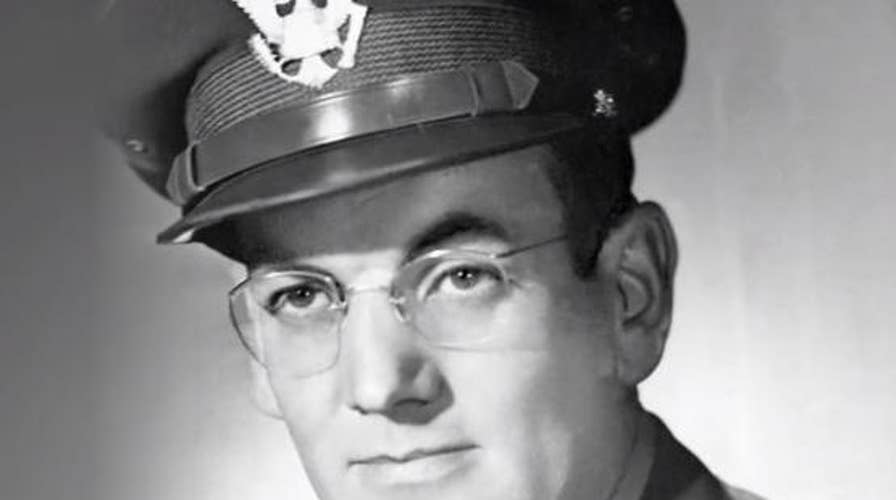Bandleader Glenn Miller’s doomed WWII plane possibly uncovered
Bandleader Glenn Miller’s doomed WWII plane has possibly been uncovered and a major aviation mystery may soon be solved.
The mystery behind what happened to Glenn Miller and his plane during World War II may finally be solved.
People magazine recently reported a retired trawlerman from England is “utterly convinced” he pulled up the wreck of the famed American bandleader’s aircraft in his fishing net 32 years ago. And now, U.S.-based historical aircraft researchers from TIGHAR say his account is “totally credible.”
RETIRED LAPD DETECTIVE: MY FATHER KILLED THE BLACK DAHLIA
According to TIGHAR, which stands for The International Group for Historic Aircraft Recovery, the man was advised to drop his unusual catch back into the English Channel, where it has remained ever since. But he recorded the coordinates and the magazine noted it is this key piece of evidence that may finally lead to the site of Miller’s final resting place.
Miller, recognized as “the hottest recording artist of his era,” dominated the swing music scene during his lifetime and was famous for his self-penned signature tune, 1939’s “Moonlight Serenade.”
But he gave up his thriving career to serve his country during World War II.
WHAT HAPPENED TO 'TOO BEAUTIFUL' ACTRESS?
He was too old to be drafted at age 38, so he volunteered for the Navy — he was told his services weren’t needed. Refusing to give up, Miller wrote to the Army’s Brigadier General Charles Young in 1942 and persuaded the Army to accept him so he could “put a little more spring into the feet of our marching men and a little more joy into their hearts and to be placed in charge of a modernized army band.”
Miller became part of the Army Specialists Corps with the rank of captain. He created and directed his own 50-member band to boost morale, deliver a touch of home to the troops, and modernize military music. In addition, he raised millions of dollars in war bonds and attracted Air Corps recruits through his radio broadcasts.
Determined to do more, Miller arranged for overseas duty with his band. Miller himself wrote that in one month, his band played at 35 different bases while performing 40 radio broadcasts in their spare time.
On Dec. 15, 1944, Miller walked across Twinwood Farm aircraft in southeast England and hopped into the passenger seat of a UC-64A Norseman light aircraft. Despite WWII still raging across Europe, Miller was heading to Paris and gearing up to continue entertaining Allied troops, as well as to make arrangements for a Christmas broadcast.
FORMER '50S STAR'S TRAGIC DOWNFALL INVOLVING DRUG ABUSE, ALCOHOLISM
The 40-year-old never made it to that show.
Somewhere between England and France, Miller and his UC-64A Norseman plane vanished. People magazine added that to date, not a single trace of the musician or the aircraft has ever been found. Along with Amelia Earhart's, it remains one of the greatest mysteries in aviation history.
The band, without Miller, went on to perform the scheduled Christmas concert. They continued to perform and played their last concert on Nov. 13, 1945 for President Truman in Washington, D.C.
But TIGHAR said there’s hope to finally discover answers.
“He’s doing his best to remember something that happened a long time ago,” TIGHAR executive director Richard Gillespie told People about the trawlerman, who is identified only as “Mr. Fisher.”
“We know human memory is fallible and can be easily influenced,” added Gillespie.
After 74 years on the sea floor, the possible missing Norseman would be largely deteriorated and unlikely “unrecognizable to the untrained eye.”
“Whatever [Fisher] pulled up in 1987 is not going to look like that anymore," explained Gillespie. “Miller’s airplane was not metal. It was a steel tube frame covered with fabric and it had some aluminum panels on it, plus of course, an engine and a propeller. By now all the fabric is almost certainly gone. The wings were wooden too, so they’re going to be gone. So, what you have got is a steel frame that very possible has been encountered by other fishermen.
CLICK HERE TO GET THE FOX NEWS APP
“You have this mangled steel frame and an engine that may or may not be fully or partially buried in the sand. So, it’s not going to look like an airplane. It’s just going to look a mess.”
However, Miller’s 1944 Norseman was noted as the only plane in England with a combined steel-tubed fuselage and “a very specific type of Pratt & Whitney engine, known as a Wasp.” Therefore, if the team finds evidence of a steel-tubed fuselage and a Pratt & Whitney Wasp, it would no doubt be Miller’s plane.
“The Miller aircraft is the only Norseman that’s unaccounted for,” said Gillespie. “So, if you find that, you’ve found the Miller aircraft.”
But Gillespie stressed the investigation is still in its early stages. The publication added the murky seabed is on the world’s busiest shipping lane and will ultimately require sending a diver 130 feet down to investigate.
“Once you say, ‘We’re going to go out and find the Glenn Miller airplane,’ everyone holds their breath,” Gillespie admitted. “But it’s a crapshoot. This stuff is really hard and there’s a good chance you’re going to get skunked! That’s what this game is like. You can’t find something if you don’t try to find it but that’s the call we’re going to have to make.”
Still, Gillespie and his team hope to finally learn what really happened to Miller on that doomed flight.
“Right now, if you really look at the facts of the case, there really isn’t much doubt at all that the airplane went down in the English Channel,” he explained. “They probably just iced up and went into the channel. But we don’t know. With a mystery as popular and iconic as the Miller disappearance, there will always be conspiracy theories and adherence to other theories.”
“Finding the wreckage answers the question finally,” he added. “You can say, ‘There it is. We can now put that to bed.’ That’s what we’re out to do: replace mystery with documented history.”







